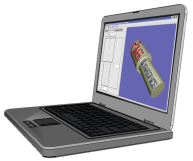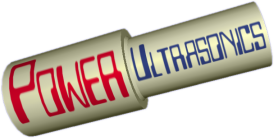Several techniques can be used to monitor the plastic welding process as it happens, allowing for 100 % quality control and even process adjustment for each individual weld. The most important are generator power and sonotrode displacement.
Ultrasonic power
Power is transmitted from the generator to the weld in many stages (electrical power to the transducer, conversion to mechanical vibrations, transmission of mechanical power to the tip of the sonotrode, transmission through the component). Some power losses can be expected at each stage, but for modern systems that have been properly set up these losses are small compared to the power dissipated in the welding process. Thus power measured electronically at the generator is a good indicator of power transmitted to the weld, and can be used as a quality control measure.
Suppose the mating surface of one component is contaminated with lubricant (perhaps mould-release) that reduces the friction coefficient at the contact points. The effect of this is to reduce the power demanded by the process, since vibration amplitude (hence velocity) is unchanged but force is reduced - power is the product of force and velocity. The reduced power demand can be monitored by the ultrasonic system and used to trigger an alarm or reject the parts.
A further refinement is to automatically adjust the weld time to compensate for the lower power - ensuring that enough total energy is supplied to perform the weld. This approach is particularly useful when parts may be slightly contaminated because welding may suffer a delayed start but then proceed normally. This "Constant energy" approach is often used in combination with pre-set time limits that will detect particularly extreme conditions (very long or short weld times) and reject these parts.
Sonotrode displacement
As discussed on the component design page, the parts are usually designed to direct or concentrate ultrasonic energy to the weld zone, which softens and flows during the welding process allowing the parts to move fully together. The small movement of the top component, and hence the sonotrode, can be readily measured, providing an automated control system with a direct measure of the progress of the weld. As with power measurement this technique can be used to extend weld times on components that require it as well as detecting fault conditions for rejection.

